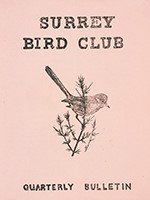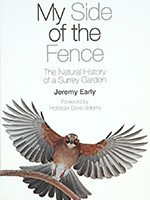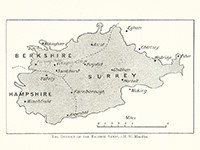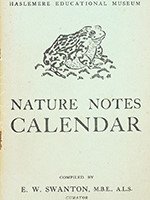 Surrey is famous for the beauty of its countryside and has a long history of attracting artists, writers and musicians who find creative inspiration in its natural surroundings. Perhaps less well-known and less celebrated are those naturalists or 'citizen scientists', who have studied and recorded the flora, fauna and other natural phenomena in the woodlands, hills, heathlands and commons of the county. Many of these individuals established or joined local societies or clubs so that they could share and debate their findings. Their publications contain a wealth of carefully gathered data and observations that are an important scientific research resource, recording in detail the changes in the natural history of the county over two centuries and contributing to our understanding of the protection of habitats, endangered species and local weather patterns.
Surrey is famous for the beauty of its countryside and has a long history of attracting artists, writers and musicians who find creative inspiration in its natural surroundings. Perhaps less well-known and less celebrated are those naturalists or 'citizen scientists', who have studied and recorded the flora, fauna and other natural phenomena in the woodlands, hills, heathlands and commons of the county. Many of these individuals established or joined local societies or clubs so that they could share and debate their findings. Their publications contain a wealth of carefully gathered data and observations that are an important scientific research resource, recording in detail the changes in the natural history of the county over two centuries and contributing to our understanding of the protection of habitats, endangered species and local weather patterns.
 The local studies library at Surrey History Centre contains many of the printed and published reports, journals and newsletters of these societies including, amongst others, the Holmesdale Natural History Club, the Croydon Natural History and Scientific Society, the Elmbridge Natural History Society, the Surrey Trust for Nature Conservation, the Surrey Naturalists' Trust, The Surrey Bird Club and the Surrey Wildlife Trust.
The local studies library at Surrey History Centre contains many of the printed and published reports, journals and newsletters of these societies including, amongst others, the Holmesdale Natural History Club, the Croydon Natural History and Scientific Society, the Elmbridge Natural History Society, the Surrey Trust for Nature Conservation, the Surrey Naturalists' Trust, The Surrey Bird Club and the Surrey Wildlife Trust.
The library also holds the published and printed records of many individual professional and amateur naturalists who gathered data and recorded their daily observations of the natural world in their locality, across specific landscapes or sometimes just their garden. The following are just a few examples.
Caroline Molesworth (1794 to 1872) of Cobham
 Caroline Molesworth was the daughter of Sir William Molesworth, 6th Baronet of Pencarrow, Cornwall. She moved to Cobham Lodge in 1823 when her widowed mother inherited the estate from a General Felix Buckley. Caroline in turn inherited it on the death of her mother in 1842 and continued living there until her own death in 1872. Almost immediately upon their arrival Caroline, whose main interest had previously been gardening and botany, began making and recording daily meteorological and phenological observations using a variety of instruments. She set out the data under 19 headings in her diaries, including hours of sunset and sunrise, several temperature readings, barometer pressure, rainfall and notes on the life cycles of plants and wildlife on the estate, including birds and insects. Described in the introduction by Eleanor Ormerod as "clever and intelligent, though not perhaps gifted with brilliant talent, yet making full use of those she possessed… with powers of patient perseverance and scrupulous accuracy" Caroline also corresponded with other observers and members of the Meteorological Society and was an active presence in local society making generous donations to local causes (see reference COB/11/1).
Caroline Molesworth was the daughter of Sir William Molesworth, 6th Baronet of Pencarrow, Cornwall. She moved to Cobham Lodge in 1823 when her widowed mother inherited the estate from a General Felix Buckley. Caroline in turn inherited it on the death of her mother in 1842 and continued living there until her own death in 1872. Almost immediately upon their arrival Caroline, whose main interest had previously been gardening and botany, began making and recording daily meteorological and phenological observations using a variety of instruments. She set out the data under 19 headings in her diaries, including hours of sunset and sunrise, several temperature readings, barometer pressure, rainfall and notes on the life cycles of plants and wildlife on the estate, including birds and insects. Described in the introduction by Eleanor Ormerod as "clever and intelligent, though not perhaps gifted with brilliant talent, yet making full use of those she possessed… with powers of patient perseverance and scrupulous accuracy" Caroline also corresponded with other observers and members of the Meteorological Society and was an active presence in local society making generous donations to local causes (see reference COB/11/1).
In her later years she recorded less and less but still made daily entries in her diaries on the general weather conditions. After her death colleagues and friends, including Eleanor A. Ormerod, herself a noted entomologist and the first female fellow of the Meteorological Society, worked to edit the diaries. The years of statistical data and nature notes were made into a useable record of tables of meteorological information and abstracts and summaries of her observations from 1825 to 1850 (although her diaries continued until 1872 but with fewer and fewer observations) including a general data table for each year divided into quarterly reports. Caroline's original diaries are now held at the Met Office and her letters and herbarium are held at Royal Botanic Gardens, Kew.
'The Cobham Journals: journals and summaries of meteorological and phenological observations made by Caroline Molesworth at Cobham, Surrey in the years 1825 to 1850', edited by Eleanor A. Ormerod (Edward Stanford, 1880) (reference 581.543 S1x)
Horace Woollaston Monckton (1857 to 1931)
 Horace Woollaston Monckton lived in the family home built by his father on land situated in the grounds of Wellington College at Crowthorne. After university he was called to the Bar and divided his time between Chambers in the Temple and Crowthorne. As a child he became interested in geology and during school holidays made studies of the rock formations on the Yorkshire and Kent coasts. In 1882 he was elected a fellow of The Geological Society and joined The Geological Association and later became a fellow of the Linnean Society and Royal Horticultural Society. He took a particular interest in the tertiary and gravel beds around Crowthorne and the Bagshot sands of the surrounding districts which extended to Winchfield in Hampshire and into Surrey including Bagshot, Chobham and Horsell (see map).
Horace Woollaston Monckton lived in the family home built by his father on land situated in the grounds of Wellington College at Crowthorne. After university he was called to the Bar and divided his time between Chambers in the Temple and Crowthorne. As a child he became interested in geology and during school holidays made studies of the rock formations on the Yorkshire and Kent coasts. In 1882 he was elected a fellow of The Geological Society and joined The Geological Association and later became a fellow of the Linnean Society and Royal Horticultural Society. He took a particular interest in the tertiary and gravel beds around Crowthorne and the Bagshot sands of the surrounding districts which extended to Winchfield in Hampshire and into Surrey including Bagshot, Chobham and Horsell (see map).
In 1880 whilst working with Sir W.H. Herries examining the land where a railway cutting had been made through the Fox Hills at Tunnel Hill they discovered that there was an abundant fauna specific to the Upper Bagshot beds. This led to a lifelong study linking botany and geology by identifying and listing plants growing on particular geological soils (see illustration). He was the author of several books including the section on geology for the Berkshire Victoria County History and was treasurer of the Linnean Society for many years. His field work led to an interest in archaeology and photography and he was a collector of English silver coins and frequently shared his interests giving lantern slide shows to pupils at Wellington College.
'The flora of the Bagshot district, the area of the main mass of the Bagshot sands' by Horace Woollaston Monckton (London, 1916) (reference 581)
Ernest William Swanton (1870 to 1958)
 Ernest William Brockton Swanton was born in Dibden in Hampshire on the edge of the New Forest where his father was a yeoman farmer. The family moved to another farm in Bratton Seymour, Somerset soon after Ernest's birth where he grew up with several brothers and sisters, later training as a teacher. In 1897 he was appointed as the first curator of the Haslemere Educational Museum where he would remain for another 50 years. The museum was founded in 1888 by the eminent surgeon Sir Jonathan Hutchinson to house his collections of natural history specimens, which he was passionate about sharing. The museum was originally housed in outbuildings and was moved twice before settling in its present location in Haslemere High Street in 1926. The ethos of the museum was always about education and Ernest Swanton was an enthusiastic teacher who encouraged local schoolchildren to visit and handle the exhibits and bring in finds from the surrounding woodlands and hedgerows. He visited local elementary schools teaching them about items from the collection and in 1899 set up the Haslemere Educational Museum Examination which required the children to spend several months studying the exhibits at the museum and learning about them.
Ernest William Brockton Swanton was born in Dibden in Hampshire on the edge of the New Forest where his father was a yeoman farmer. The family moved to another farm in Bratton Seymour, Somerset soon after Ernest's birth where he grew up with several brothers and sisters, later training as a teacher. In 1897 he was appointed as the first curator of the Haslemere Educational Museum where he would remain for another 50 years. The museum was founded in 1888 by the eminent surgeon Sir Jonathan Hutchinson to house his collections of natural history specimens, which he was passionate about sharing. The museum was originally housed in outbuildings and was moved twice before settling in its present location in Haslemere High Street in 1926. The ethos of the museum was always about education and Ernest Swanton was an enthusiastic teacher who encouraged local schoolchildren to visit and handle the exhibits and bring in finds from the surrounding woodlands and hedgerows. He visited local elementary schools teaching them about items from the collection and in 1899 set up the Haslemere Educational Museum Examination which required the children to spend several months studying the exhibits at the museum and learning about them.
Ernest married in 1900 and his wife Annie took on the role of librarian at the museum and worked with her husband collecting and identifying fungi which were his passion. In 1898 he was one of the founding members of the British Mycological Society, of which he was president in 1915-16 and published A preliminary list of Haslemere fungi (Haslemere Microscope and Natural History Society, 1903) [reference 589.2] and a popular field guide to collecting, Fungi and how to know them (Methuen, 1909), which was updated and republished in 1922. Swanton was also interested in local history, publishing Bygone Haslemere : a short history of the ancient borough and its immediate neighbourhood from its earliest times (West, Newman and Co, 1914) [reference 942.2HAS] and several ramblers guides to the local area, but natural history and field studies were his main joys and he produced several booklets on local natural history available in the local studies library. He was awarded the MBE in 1936 and the OBE in 1948.
'Nature notes calendar', compiled by E.W. Swanton (Haslemere Educational Museum, circa 1936)
Sources
- Mr. H. W. Monckton. Nature 127, 206 (1931)
- CLEGG, J. Mr. E. W. Swanton, O.B.E.. Nature 182, 1412 (1958)
- Misidentifying fungi, blog by Clare Blencow of Sussex Biodiversity Record Centre
Images
- Cover of Surrey Bird Club quarterly bulletin
- Cover of Jeremy Early's, 'My side of the fence: the natural history of a Surrey garden' (2013)
- Cover of 'The Cobham Journals: journals and summaries of meteorological and phenological observations made by Caroline Molesworth at Cobham, Surrey in the years 1825 to 1850', edited by Eleanor A. Ormerod (2015)
- Map in H W Monckton's 'The Flora of the Bagshot Sands' (1916)
- Cover of 'Nature notes calendar' compiled by E W Swanton (circa 1936)

